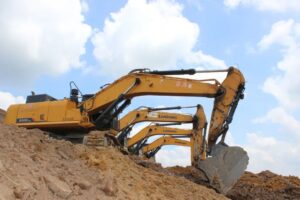
Excavator powerlessness is a very common fault of excavators. The main reason is that the engine, hydraulic pump, distribution valve, and external load do not match. However, this fault has many specific manifestations and is difficult to eliminate and repair.
Excavator powerlessness is closely related to the engine condition and can generally be divided into two situations:
1. Excavator powerlessness and engine does not shut down
The size of the excavation force depends on the output pressure of the main pump, and the engine flameout depends on the relationship between the oil pump absorption torque and the engine output torque. If the engine does not shut down, it means that the oil pump absorption torque is small and the engine load is light. The maximum output pressure (system overflow pressure) of the main pump should be checked. If the overflow pressure value is lower than the specified value, it means that the overload overflow valve setting value of the hydraulic circuit of the mechanism is incorrect. At this time, the adjustment screw needs to be turned for mechanical adjustment.
2. Excavator powerlessness and serious engine flameout
The engine flameout indicates that the absorption torque of the oil pump is greater than the engine output torque and the engine is overloaded. This fault is mostly caused by abnormal engine speed sensing system. As long as the engine speed sensing system returns to normal, the flameout fault can be eliminated.
According to the specific symptoms, the excavator powerlessness phenomenon can be divided into the following 5 types:
1. Excavator powerlessness
(1) If the excavator is powerless when it is cold, you can check the main overflow valve, unloading valve, hydraulic pump, PC-EPC valve, engine speed sensor, distributor oil seal, control valve, pilot valve, regulating valve and other faults.
(2) If the excavator is powerless after warming up, in addition to checking the above faults, you should also check the hydraulic oil. Dirty oil will contaminate the hydraulic system of the excavator and cause internal leakage of the hydraulic system. In addition, powerlessness after warming up may also be caused by wear of the main pump. As the temperature of the excavator hydraulic oil increases, oil leakage will also increase, resulting in insufficient pressure in the excavator.
2. The excavator is unable to move
(1) The excavator engine has been overloaded for a long time, resulting in insufficient power and no gas;
(2) The PC valve of the excavator is worn or damaged;
(3) The overflow pressure of the excavator travel motor is incorrect or the overflow valve of the excavator travel motor is worn;
(4) The main overflow valve of the excavator is adjusted defectively;
(5) The travel pressure values of the travel motors on the left and right sides of the excavator are inconsistent.
3. The excavator cannot rotate (swing)
(1) The excavator line is faulty. It is necessary to check the voltage and resistance values of the excavator wire control display screen and each connector in detail.
(2) Hydraulic failure, wear of the internal components of the excavator swing pump, wear of the excavator oil distribution plate (distribution plate), damage of the excavator pump control valve, the left and right swing pressure values of the excavator are too high or too low, the internal pressure of the swing pump is released, the seal of the excavator swing motor fails, the overflow width is improperly adjusted, and the swing motor is overloaded.
4. The excavator boom cannot be raised
(1) The oil supply pipeline of the large (small) arm is blocked, and the oil supply is not smooth; the filter screen of the oil pump suction port is blocked, and the oil pump cannot suck oil.
(2) The large (small) arm cylinder is leaking oil/air.
(3) The large (small) arm pressure retaining valve is stuck or damaged.
(4) The hydraulic oil tank is insufficient. (5) The overflow valve is blocked or damaged.
5. The excavator bucket (arm) cannot be extended or retracted
(1) The multi-way valve (main control valve) system is stuck or leaking oil.
(2) The valve core of the multi-way valve upper arm oil circuit is worn.
(3) The bucket (arm) cylinder assembly is worn or damaged.
(4) The valve core of the bucket (arm) slide valve is stuck or worn.
(5) The return spring force of the check valve of the bucket (arm) regeneration circuit valve is too weak.
